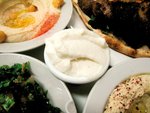

The recipe for toum contains only garlic, salt, lemon juice and olive oil. It’s as thick and creamy as mayo and improves everything it touches. But before it’s time for toum, we have to discuss the initial task: It’s time to plant the garlic.
Autumn is not the usual time for planting, but garlic is the exception. As the frost prepares to blanket the garden, garlic growers of the north are tucking in their cloves beneath layers of insulating mulch.
Garlic is also exceptional because it’s one of the few garden crops that doesn’t begin as a seed. You plant actual garlic, the same garlic that you could just as easily slice into a pan. But that doesn’t mean we simply bring home garlic from the supermarket and push it into the ground.
Commercial garlic may carry diseases that could infect your garden. It could be beaten up and bruised, making it more susceptible to rotting in the ground. Unless you do your gardening in California or China, the garlic at your local store won’t be local to your region. You want garlic that can make itself at home where you plant it.
So, buying it locally from your farmers market or a farmstand in your area is better. Look for garlic you like, as it will closely resemble the next generation. You can ask the grower questions like: is it a hardneck or softneck? Hardneck garlic will sprout the edible scapes everyone loves in the late spring. Softnecks store much better and often have more intense heat. Whatever garlic you like at the farmers market is bound to grow at home. If all goes well, you won’t need to buy more next year.
I use a hardneck variety called Romanian red. The cloves are always big, so it’s easy to peel and tastes fantastic. Some call it the stinking rose, but I prefer fragrant lily. Garlic is a member of the lily family, after all. As for stinking, I would say it smells provocatively pungent. When you cut and cook garlic, the fragrance lights up the room and makes everyone hungry.
The absolute deadline for garlic planting is when the ground freezes, after which the soil can no longer be worked. But it’s better to get it in a few weeks before that point so the clove can send roots into the damp fall earth. Ideally, we would dig the earth weeks before planting on a sunny fall day.
Break the bulbs into cloves, and plant them 4-8 inches apart with the flat, scabby side facing down. I have a garlic planting tool that you push into the ground, making the perfect-sized hole for dropping a clove into. You can also dig a little trench and plant the cloves into that.
Don’t cover anything until all the cloves are planted, or you might lose sight of where they are. When all the cloves are in, gently rake the dirt, then cover everything with a thick blanket of leaves, straw or mulch. In early spring, peel back some of the mulch and look for green shoots. When you find them, pull back the mulch as necessary to allow them to grow. In the meantime, here is a recipe to help us enjoy what we sow.
Toum
This Lebanese spread is a stunning and simple way to enjoy fresh garlic and will find many ways into your mouth. On bread, atop the feast, or as an ingredient in marinade, dressing or sauce. You will need a blender, a food processor, a large mortar and pestle — and lots of elbow grease.
Support City Pulse - Donate Today!
Comments
No comments on this item Please log in to comment by clicking here